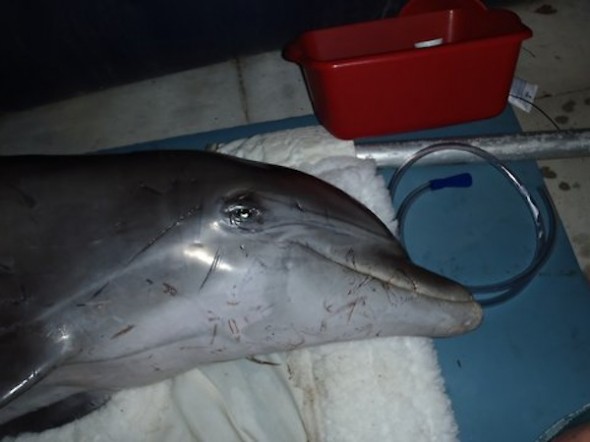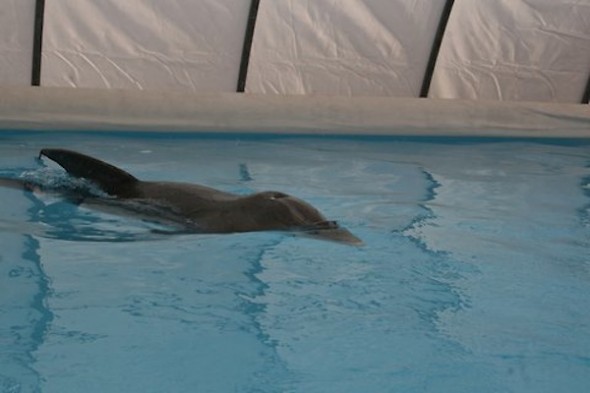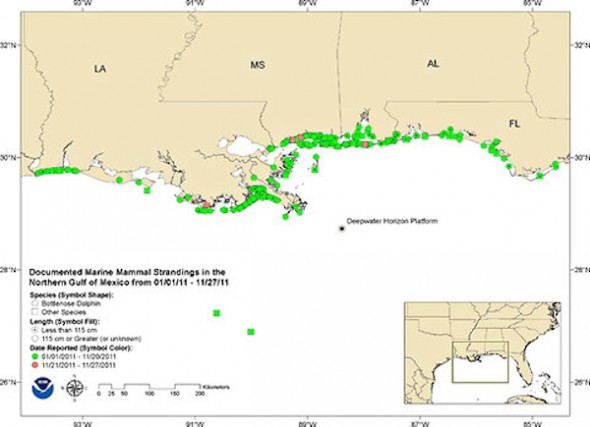
An injured dolphin as it appeared when rescued in Alabama last week. Photo: Institute for Marine Mammal Studies
I read an interesting post in the New York Times Green blog about the dolphin die-off in the Gulf of Mexico. Since early 2010 dead dolphins have been washing ashore at an alarming rate and among the many possible explanations for the 600 dead dolphins is — of course — the BP oil spill. According to the article, which I’m pasting below, scientists are not yet able to determine the cause of the die-off.
This made me think of the recent rash of beached dead whales in Ghana, which, according to the Ghana EPA, is unrelated to the country’s oil activities. I wonder how the Ghana EPA was able to make such a determination so quickly. The New York Times piece gives the impression that determining the exact cause of death of these beached mammals is quite complicated.
Here’s the article:
By Rachel Nuwer
Four more dolphins washed up on the shores of the Gulf of Mexico this week. For coastal residents from Louisiana to Florida, the beached animals are a familair sight: hundreds of decomposing dolphin carcasses have turned up over the last two years.
But last week, Alabama residents came across a stranded dolphin that was still alive, though badly injured.
Moby Solangi, director of the Institute for Marine Mammal Studies in Gulfport, Miss., where the rescued dolphin is being cared for and studied, said the discovery presented the institute’s first opportunity in two years to examine a live dolphin that was ill.
The researchers hope that studying the dolphin will yield clues to the principal cause of the die-off. “People in Alabama call it Chance,” Dr. Solangi said of the survivor.
Residents found the dolphin, a male about 2 years old and six feet long, on Nov. 23 in a marshy area near the mouth of Mobile Bay. They tried to push it back into the water, but it continued to beach itself.
When rescue workers arrived, they noted that the mammal was severely dehydrated, covered with scrapes and bruises, and plagued by parasites like barnacles and nematodes. They gave it a 50-50 chance of survival. It is holding on and perhaps recovering, although it is still “not out of the woods,” Dr. Solangi said.
Since Feb. 1, 2010, nearly 600 bottlenose dolphins, a species that under federal law is protected but not technically endangered, have washed ashore in the region. Normally, only about 60 dead dolphins wash up each year on the Gulf Coast. (A map below highlights the locations where they were found.)
“There’s no way to determine at this point if stranding rates will go down,” said Teri Rowles, coordinator of marine mammal health and the stranding response program at the National Oceanic and Atmospheric Administration.
Many residents suggest that the three-month Deepwater Horizon oil spill, which began in April 2010, is responsible. Scientists say it is too soon to tell. Researchers from about 20 federal, state and academic organizations are collaborating to find a cause for the deaths.
Because the dead dolphins are often badly decomposed when discovered, collecting tissue samples for analysis is not always possible. Only about 11 percent of those found are “fresh dead,” Dr. Rowles said. So far, the bacterium Brucella has been identified in samples from five dolphins.
“There are many, many reasons why dolphins strand,” Dr. Rowles said, “ranging from nutritional issues, early weaning, death of the mother, infectious disease and biotoxins.”
Fetuses and newborns are notable among the casualties. In February alone, 34 baby dolphins were found dead. In previous years, including 2010, only one dead baby dolphin was typically found each February.
Dolphin gestation takes about 12 months, so an animal conceived in March might be born in February, March or April of the following year.
In December 2010, NOAA declared an “unusual mortality event” in the Gulf of Mexico. As defined by the Marine Mammal Protection Act, such a die-off demands an immediate response from the government. Since 1991, the agency has investigated 15 unusual mortality events in the Gulf of Mexico, most of them involving dolphins. About half of those events were caused by biotoxins.

The dolphin a few days after its rescue when it had resumed eating. Photo: Institute for Marine Mammal Studies
The injured dolphin has started eating, and Dr. Solangi and his team have put it on antibiotics and supplements. “We worked on it 24/7,” he said. Researchers now think the animal has an 80 percent chance of survival.
The live dolphin could help fill in missing gaps, although the researchers still do not know whether its illness is the same one that caused the mass strandings. “It may provide a window on what is happening out there,” Dr. Solangi said.
It could be many weeks or even months before researchers determine whether the injured dolphin can be released back into the wild, he said.

The green circles indicate where stranded dolphins have been found along the Gulf Coast since February 2010, and the pink circles indicate where they have been found in the past week. The squares indicate other beached species. Photo: NOAA
New York Times, December 1, 2011
